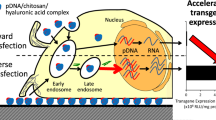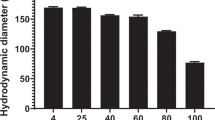Abstract
Chitosans have been proposed as alternative, biocompatible cationic polymers for nonviral gene delivery. However, the low transfection efficiency and low specificity of chitosan need to be addressed before clinical application. We prepared galactosylated chitosan-graft-polyethylenimine (GC-g-PEI) copolymer by an imine reaction between periodate-oxidized GC and low-molecular-weight PEI. The molecular weight and composition were characterized using gel permeation chromatography column with multi-angle laser scattering and 1H nuclear magnetic resonance, respectively. The copolymer was complexed with plasmid DNA in various copolymer/DNA (N/P) charge ratios, and the complexes were characterized. GC-g-PEI showed good DNA-binding ability and superior protection of DNA from nuclease attack and had low cytotoxicity compared to PEI 25K. GC-g-PEI/DNA complexes showed higher transfection efficiency than PEI 25K in both HepG2 and HeLa cell lines. Transfection efficiency into HepG2, which has asialoglycoprotein receptors, was higher than that into HeLa, which does not. GC-g-PEI/DNA complexes also transfected liver cells in vivo after intraperitoneal (i.p.) administration more effectively than PEI 25K. These results suggest that GC-g-PEI can be used in gene therapy to improve transfection efficiency and hepatocyte specificity in vitro and in vivo.
This is a preview of subscription content, access via your institution
Access options
Subscribe to this journal
Receive 12 print issues and online access
$259.00 per year
only $21.58 per issue
Buy this article
- Purchase on Springer Link
- Instant access to full article PDF
Prices may be subject to local taxes which are calculated during checkout







Similar content being viewed by others
References
Hackett NR, Crystal RG . Adenovirus vector for gene therapy.In: Templeton NS, Lasic DD (eds). Gene Therapy: Therapeutic Mechanisms and Strategies. Marcel Dekker: New York, 2000,pp 17–40.
Gao S, Chen J, Xu X, Ding Z, Yang YH, Hua Z et al. Galactosylated low molecular weight chitosan as DNA carrier for hepatocyte-targeting. Int J Pharm 2003; 255: 57–68.
Verma IM, Somia N . Gene therapy-promises, problems and prospects. Nature 1997; 389: 239–242.
Parkes RJ, Hart SL . Adhesion molecules and gene transfer. Adv Drug Deliv Rev 2000; 44: 135–152.
Brown MD, Schatzlein AG, Uchegbu IF . Gene delivery with synthetic (non viral) carriers. Int J Pharm 2001; 229: 1–21.
Anderson WF . Human gene therapy. Nature 1998; 392: 25–30.
Köping-Höggård M, Vårum KM, Issa M, Danielsen S, Christensen BE, Stokke BT et al. Improved chitosan-mediated gene delivery based on easily dissociated chitosan polyplexes of highly defined chitosan oligomers. Gene Therapy 2004; 11: 1441–1452.
Kim TH, Kim SI, Akaike T, Cho CS . Synergistic effect of poly(ethylenimine) on the transfection efficiency of galactosylated chitosan/DNA complexes. J Control Release 2005; 105: 354–366.
Mansouri S, Cuie Y, Winnik F, Shi Q, Lavigne P, Benderdour M et al. Characterization of folate-chitosan-DNA nanoparticles for gene therapy. Biomaterials 2006; 27: 2060–2065.
Mao HQ, Roy K, Troung-Le VL, Janes KA, Lin KY, Wang Y et al. Chitosan-DNA nanoparticles as gene carriers: synthesis, characterization and transfection efficiency. J Control Release 2001; 70: 399–421.
Zhang H, Mardyani S, Chan WC, Kumacheva E . Design of biocompatible chitosan microgels for targeted pH-mediated intracellular release of cancer therapeutics. Biomacromolecules 2006; 7: 1568–1572.
Chan P, Kurisawa M, Chung JE, Yang YY . Synthesis and characterization of chitosan-g-poly(ethylene glycol)-folate as a non-viral carrier for tumor-targeted gene delivery. Biomaterials 2007; 28: 540–549.
Kim TH, Nah JW, Cho MH, Park TG, Cho CS . Receptor-mediated gene delivery into antigen presenting cells using mannosylated chitosan/DNA nanoparticles. J Nanosci Nanotechnol 2006; 6: 2796–2803.
Park IK, Kim TH, Park YH, Shin BA, Choi ES, Chowdhury EH et al. Galactosylated chitosan-graft-poly(ethylene glycol) as hepatocyte-targeting DNA carrier. J Control Release 2001; 76: 349–362.
Kim TH, Park IK, Nah JW, Choi YJ, Cho CS . Galactosylated chitosan/DNA nanoparticles prepared using water-soluble chitosan as a gene carrier. Biomaterials 2004; 25: 3783–3792.
Ledley FD . Hepatic gene delivery: present and future. Hepatology 1993; 18: 1263–1273.
Wu CH, Wu GY . Receptor-mediated delivery of foreign genes to hepatocytes. Adv Drug Deliv Rev 1998; 29: 243–248.
Ashwell G, Harford J . Carbohydrate-specific receptors of the liver. Annu Rev Biochem 1982; 51: 531–554.
Ashwell G, Morell AG . The role of surface carbohydrates in the hepatic recognition and transport of circulating glycoproteins. Adv Enzymol Relat Areas Mol Biol 1974; 41: 99–128.
Park IK, Park YH, Shin BA, Choi ES, Park YR, Akaike T et al. Galactosylated chitosan-graft-dextran as hepatocyte-targeting DNA carrier. J Control Release 2000; 9: 97–108.
Park IK, Ihm JE, Park YH, Choi YJ, Kim SI, Kim WJ et al. Galactosylated chitosan (GC)-graft-poly(vinyl pyrrolidone) (PVP) as hepatocyte-targeting DNA carrier. Preparation and physicochemical characterization of GC-graft-PVP/DNA complex (1). J Control Release 2003; 86: 349–359.
Godbey WT, Wu KK, Mikos AG . Poly(ethylenimine) and its role in gene delivery. J Control Release 1999; 60: 149–160.
Neu M, Fischer D, Kissel T . Recent advances in rational gene transfer vector design based on poly(ethylene imine) and its derivatives. J Gene Med 2005; 7: 992–1009.
Fischer D, Bieber T, Li YX, Elsasser HP, Kissel T . A novel nonviral vector for DNA delivery based on low molecular weight, branched polyethylenimine: effect of molecular weight on transfection efficiency and cytotoxicity. Pharm Res 1999; 16: 1273–1279.
Kunath K, von Harpe A, Fischer D, Petersen H, Bickel U, Voigt K et al. Low-molecular-weight polyethylenimine as a non-viral vector for DNA delivery: comparison of physicochemical properties, transfection efficiency and in vivo distribution with high-molecular-weight polyethylenimine. J Control Release 2003; 89: 113–125.
Jiang HL, Kim YK, Arote R, Nah JW, Cho MH, Choi YJ et al. Chitosan-graft-polyethylenimine as a gene carrier. J Control Release 2007; 117: 273–280.
Park MR, Han KO, Han IK, Cho MH, Nah JW, Choi YJ et al. Degradable polyethylenimine-alt-poly(ethylene glycol) copolymers as novel gene carriers. J Control Release 2005; 105: 367–380.
Inger MNV, Christensen BE . Periodate oxidation of chitosans with different chemical compositions. Carbohydr Res 2005; 340: 679–684.
Remy JS, Abdallah B, Zanta MA, Boussif O, Behr JP, Demenix B . Gene transfer with lipospermines and polyethylenimines. Adv Drug Deliv Rev 1998; 30: 85–95.
Petersen H, Fechner PM, Martin AL, Kunath K, Stolnik S, Roberts CJ et al. Polyethylenimine-graft-poly(ethylene glycol) copolymers: influence of copolymer block structure on DNA complexation and biological activities as gene delivery system. Bioconjug Chem 2002; 13: 845–854.
Bottega R, Epand RM . Inhibition of protein kinase C by cationic amphiphiles. Biochemistry 1992; 31: 9025–9030.
Wong K, Sun G, Zhang X, Dai H, Liu Y, He C et al. PEI-g-chitosan, a novel gene delivery system with transfection efficiency comparable to polyethylenimine in vitro and after liver administration in vivo. Bioconjugate Chem 2006; 17: 152–158.
Hong S, Leroueil PR, Janus EK, Peters JL, Kober MM, Islam MT et al. Interaction of polycationic polymers with supported lipid bilayers and cells: nanoscale hole formation and enhanced membrane permeability. Bioconjug Chem 2006; 17: 728–734.
Moghimi SM, Symonds P, Murray JC, Hunter AC, Debska G, Szewczyk A et al. A two-stage poly(ethylenimine)-mediated cytotoxicity: implications for gene transfer/therapy. Mol Ther 2005; 11: 990–995.
Illum L . Chitosan and its use as a pharmaceutical excipient. Pharm Res 1998; 30: 85–95.
Carreno-Gomez B, Duncan R . Evaluation of the biological properties of soluble chitosan and chitosan microspheres. Int J Pharm 1997; 148: 231–240.
Schipper NG, Vårum KM, Artursson P . Chitosans as absorption enhancers for poorly absorbable drugs. 1: influence of molecular weight and degree of acetylation on drug transport across human intestinal epithelial (Caco-2) cells. Pharm Res 1996; 13: 1686–1692.
Chang SW, Westcott JY, Henson JE, Voelkel NF . Pulmonary vascular injury by polycations in perfused rat lungs. J Appl Physiol 1987; 62: 1932–1943.
Boussif O, Lezoualc’h F, Zanta MA, Mergny MD, Scherman D, Demeneix B et al. A versatile vector for gene and oligonucleotide transfer into cells in culture and in vivo: polyethylenimine. Proc Natl Acad Sci USA 1995; 92: 7297–7301.
Zenta MA, Boussif O, Adib A, Behr JP . In vitro gene delivery to hepatocytes with galactosylated polyethylenimine. Bioconjugate Chem 1997; 8: 839–844.
Cook SE, Park IK, Kim EM, Jeong HJ, Park TG, Choi YJ et al. Galactosylated polyethylenimine-graft-poly(vinyl pyrrolidone) as a hepatocyte-targeting gene carrier. J Control Release 2005; 105: 151–163.
Sagara K, Kim SW . A new synthesis of galactose-poly(ethylene glycol)-polyethylenimine for gene delivery to hepatocytes. J Control Release 2002; 79: 271–281.
Santana A, Hyslop S, Antunes E, Mariano M, Bakhle YS, de Nucci G . Inflammatory responses induced by poly-L-arginine in rat lungs in vivo. Agents Actions 1993; 39: 104–110.
Hattori Y, Kawakami S, Nakamura K, Yamashita F, Hashida M . Efficient gene transfer into macrophages and dendritic cells by in vivo gene delivery with mannosylated lipoplex via the intraperitoneal route. J Pharmacol Exp Ther 2006; 318: 828–834.
Cai SR, Xu G, Mcleod HL, Ma M, Dowdy SF, Mcleod HL . The kinetics and tissue distribution of protein transduction in mice. Euro J Pharm Sci 2006; 27: 311–319.
Kim EM, Jeong HJ, Park IK, Cho CS, Moon HB, Yu DY et al. Asialoglycoprotein receptor targeted gene delivery using galactosylated polyethylenimine-graft-poly(ethylene glycol): in vitro and in vivo studies. J Control Release 2005; 108: 557–567.
Acknowledgements
This work was supported by the grants from Ministry of Science and Technology in Korea (F104AA010001-06A0101-00111). We thank the National Instrumentation Center for Environmental Management (NICEM) for permission to take NMR measurements. HL Jiang was supported by the BK21 grant.
Author information
Authors and Affiliations
Corresponding authors
Rights and permissions
About this article
Cite this article
Jiang, HL., Kwon, JT., Kim, YK. et al. Galactosylated chitosan-graft-polyethylenimine as a gene carrier for hepatocyte targeting. Gene Ther 14, 1389–1398 (2007). https://doi.org/10.1038/sj.gt.3302997
Received:
Revised:
Accepted:
Published:
Issue Date:
DOI: https://doi.org/10.1038/sj.gt.3302997
Keywords
This article is cited by
-
Gene delivery using layer-by-layer functionalized multi-walled carbon nanotubes: design, characterization, cell line evaluation
Journal of Materials Science (2021)
-
BMP2 gene delivery to bone mesenchymal stem cell by chitosan-g-PEI nonviral vector
Nanoscale Research Letters (2015)
-
Nanostructured manganese oxide–chitosan-based cholesterol sensor
Journal of Applied Electrochemistry (2014)
-
Octaarginine-modified chitosan as a nonviral gene delivery vector: properties and in vitro transfection efficiency
Journal of Nanoparticle Research (2011)
-
Galactosylated chitosan-g-PEI/DNA complexes-loaded poly(organophosphazene) hydrogel as a hepatocyte targeting gene delivery system
Archives of Pharmacal Research (2010)



